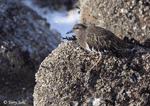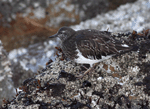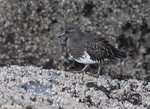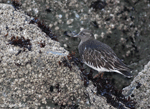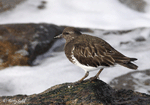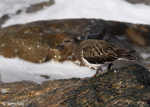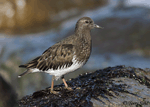| Length: 9 inches | Wingspan: 21 inches | Seasonality: Non-resident in South Dakota |
| ID Keys: Stocky structure, blackish upperparts and white underparts, relatively stout dark bill | ||
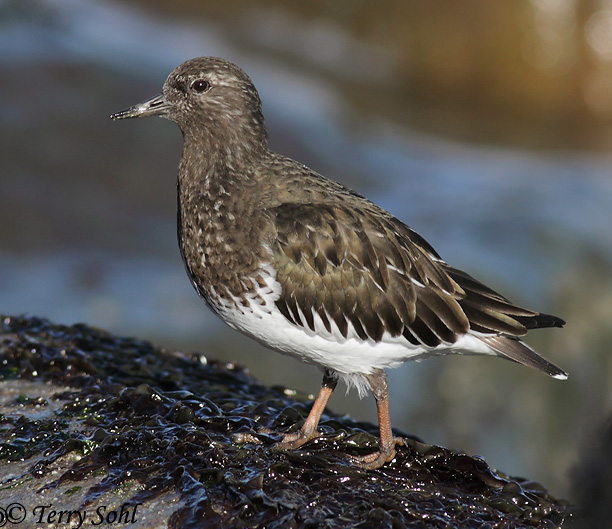 The
Black Turnstone is associated with the rocky shorelines of much of the
western coast of North America, where they can be found overwintering and
when in migration. They actively forage for barnacles and limpets
while clambering over rocks near the surfline. They are often joined
in this rocky habitat by Surfbirds.
The species breeds in a limited range along the western coast of Alaska, and
the global population has been estimated at less than 100,000, but
populations generally seem to be stable at this time.
The
Black Turnstone is associated with the rocky shorelines of much of the
western coast of North America, where they can be found overwintering and
when in migration. They actively forage for barnacles and limpets
while clambering over rocks near the surfline. They are often joined
in this rocky habitat by Surfbirds.
The species breeds in a limited range along the western coast of Alaska, and
the global population has been estimated at less than 100,000, but
populations generally seem to be stable at this time.
Habitat: During migration and in winter, they are found on rocky shorelines and rocky islands. During the summer breeding season, they are found on tundra, typically near the coast.
Diet: During migration and in winter, they primarily feed on mollusks and crustaceans. In summer on the breeding grounds, they feed heavily on insects and spiders. They will also sometimes eat seeds and berries in the summer.
Behavior: Small flocks of Black Turnstones form in the winter and in migration, with foraging usually done communally.
Nesting: Pairs of Black Turnstones are thought to mate for life. The nest of a Black Turnstone is built in a shallow depression on the ground, and is primarily constructed of grasses lining the depression. Both parents help to incubate the eggs, and both parents will tend to the young for the first few weeks, although the female usually departs the breeding grounds before the male.
Song: The song of the Black Turnstone is a long rattling trill with variations in pitch and tone. They also have a crispy chattering flight call.
Migration: Highly migratory, the Black Turnstone summers in a few select locations on the western and northern Alaskan coast. The summer range includes the coastline of much of western North America.
Interactive eBird Map: Click to access an interactive eBird map of Black Turnstone sightings
Similar Species: Very similar in structure to the Ruddy Turnstone, but plumage differences are generally obvious.
Conservation Status: The range of the Black Turnstone is quite large, and population trends are not severe, thus the IUCN cites Black Turnstones as a species of "Least Concern". However, the breeding range of the species is relatively limited, leading Partners in Flight to list it as a species of "Special Concern", while the U.S Shorebird Conservation Plan lists it as a "Species of High Concern".
Further Information: 1) Audubon.org - Black Turnstone
2) BirdWeb.org - Black Turnstone
3) WhatBird - Black Turnstone
Photo Information: December 2011 - Coastal California near San Francisco - Terry Sohl
| Click below for a higher-resolution map |
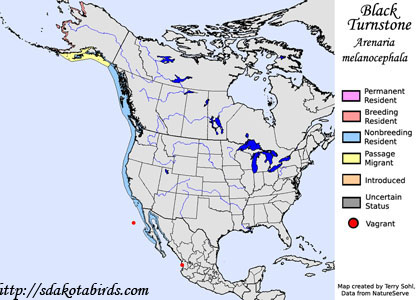 |
| South Dakota Status: Non-resident in South Dakota |
Additional Black Turnstone Photos
Click for a higher-resolution version of these photos

